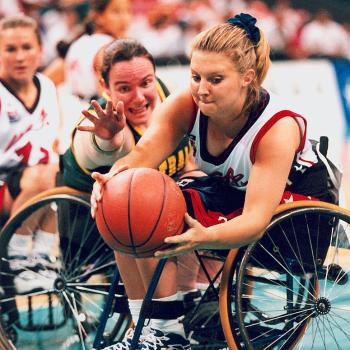Over at Sherry Weddell’s Forming Intentional Disciples Forum, someone asked:
Anyone have any thoughts on how to approach teaching sacraments to high school students in an evangelizing way?
The other responses were excellent, and helped me form my thoughts. Building on the ideas of several others, here’s my answer:
Everything you teach, you put in the context of the Good News. The sacraments are all about your relationship with God.
When describing what happens in the sacraments, use active voice rather than passive voice.
Not Enough: “In baptism, original sin is removed.”*
Explain: “When you ask for Baptism, you are asking God to come into your life and remove all sin from your soul. You are asking Him to remove every barrier that separates you from Him, so that you and the Lord can again share the intimacy and loving bond that He created you to experience.”
Not Enough: “In the sacrament of reconciliation, mortal sins are removed and supernatural grace is bestowed upon the soul.”
Yes: “In the sacrament of confession, you are approaching our Lord and asking Him to forgive you of your sins. It is, in its essence, apologizing to Jesus. You are rebuilding your friendship with God, just like you’d have to do some “rebuilding” if you’d had a fight with one of your friends, or with your mom or dad. The thing about the sacrament is that God is always, always, waiting for you to come to Him, because He desperately wants to be in a relationship with you. You never ever have to worry that you’ve done something unforgivable. No matter how far you’ve gotten away from God, He always wants you back in His arms.”
And so forth. Meditate upon the sacraments. The theology is beautiful. It’s beautiful because God is beautiful. The study of God is the study of the one most beautiful thing.
Can There Be Too Much Mercy?
One of the fears that some faithful Catholics have expressed is that in teaching God’s mercy and forgiveness, we risk teaching an all-approving teddy bear god. If your definition of “mercy” is “everything you do is just fine,” then yes, you are teaching about a false god. If your definition of “forgiveness” is “you didn’t really do anything wrong,” then yes, again, you are teaching a false god.
One of the joys of teaching young people is that they do have a keen sense of justice. Just ask any child who’s been given 2% less ice cream than his sibling: It is possible to sin against God and man.
Without the hope of forgiveness, the sinner has two choices: Condemnation or flight. If you stay and admit your sin, you will be condemned. To avoid condemnation, if there is no forgiveness you must either deny you have sinned or flee the condemner.
It is important, therefore, that we give teens a clear sense of what forgiveness is: You actually did something wrong. Something truly evil. And now the person you harmed is willing to restore his relationship with you.
After you have established, firmly, this understanding of forgiveness, it becomes possible to both teach about God’s bountiful mercy and to teach teens how to examine their consciences.
Because forgiveness (and sin) is such an alien concept in our culture, plan to repeat the definition of forgiveness every class period. Likewise, plan to repeat a short version of the Good News every class period. 60 seconds a class devoted to re-grounding your students in the Gospel, and then you can teach all the rest with much more success.
*Updated for Clarification: you should give your students the concise technical definitions of the sacraments. Absolutely yes. But you don’t leave it there. Preach that Good News in your explanations.
Artwork: By Jagba (Own work) [GFDL or CC BY-SA 4.0-3.0-2.5-2.0-1.0], via Wikimedia Commons













